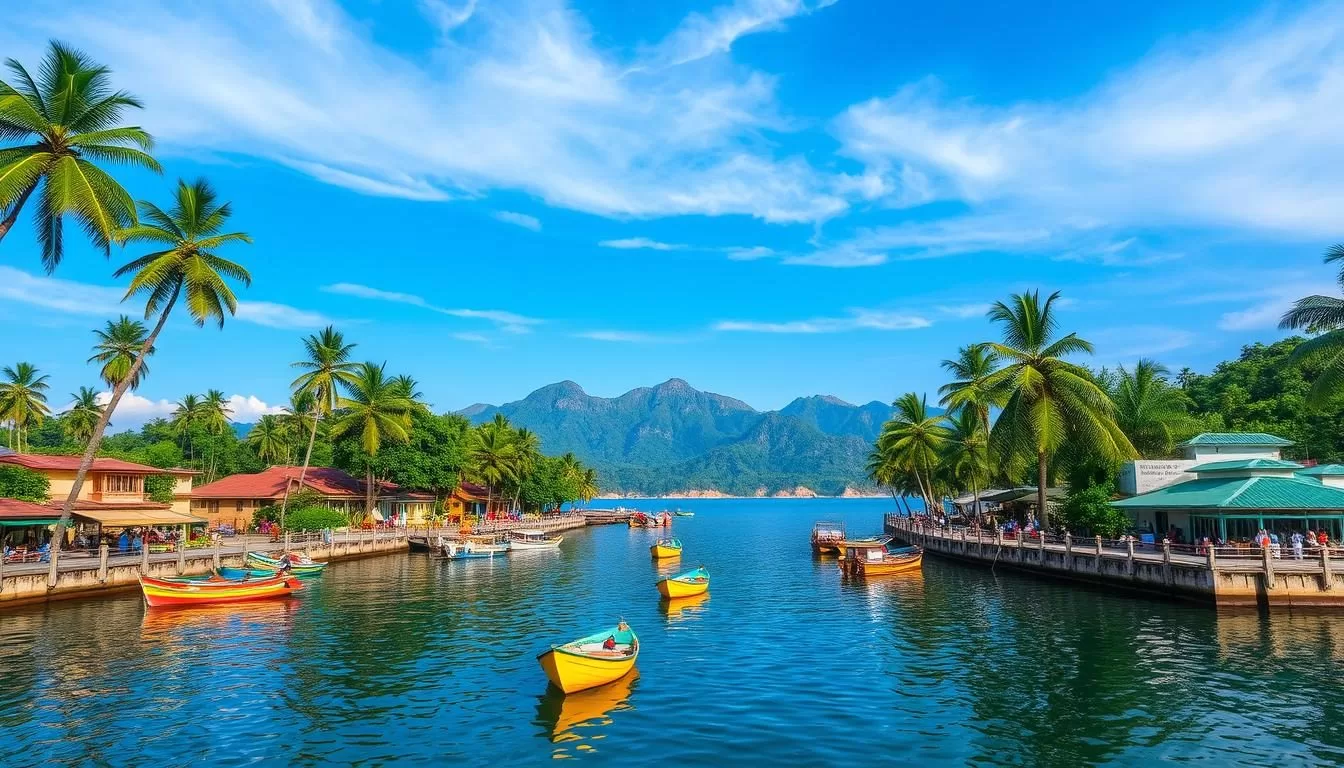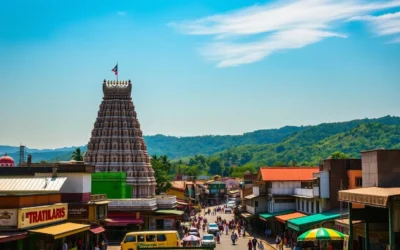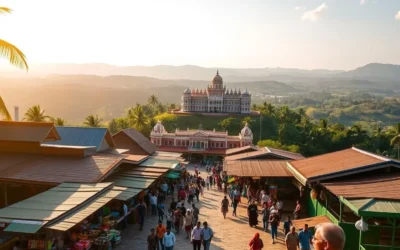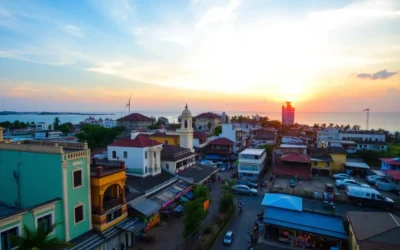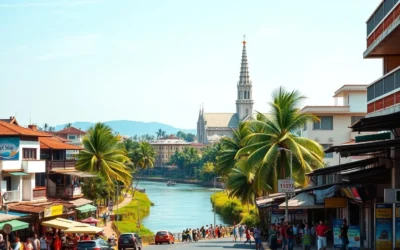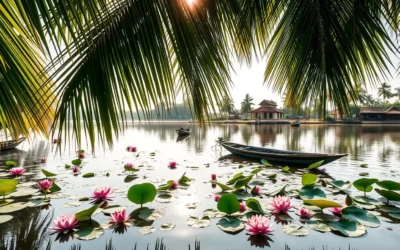Planning a trip to Kerala, known as “God’s Own Country,” can be a thrilling experience. With its diverse landscapes, from pristine beaches to misty hill stations, Kerala offers something unique throughout the year.
However, the time you choose to visit can significantly impact your travel experience. The state’s climate varies throughout the year, with three distinct patterns that offer different advantages and challenges for travelers.
Understanding Kerala’s weather is crucial for a trip that aligns with your preferences. This guide will help you navigate the seasonal variations to determine the ideal time for your visit, ensuring a memorable travel experience in this beautiful country.
Understanding Kerala’s Tropical Climate
The tropical climate of Kerala, India, is marked by three distinct seasons and regional variations in weather conditions. Kerala is known for its lush greenery, which is largely due to its high rainfall throughout the year.
The Three Distinct Seasons
Kerala experiences three main seasons: winter, summer, and monsoon. The weather conditions vary significantly across these seasons, influencing the best time to visit Kerala. Winters are generally cool and dry, summers are hot and humid, and monsoons bring heavy rainfall.
The state’s geography, including the Western Ghats, plays a crucial role in shaping its climate. The varied conditions across different regions make some areas more suitable for visitation during specific seasons.
Regional Climate Variations
Kerala’s geography creates distinct microclimates across its three main regions: the coastal belt, midlands, and highlands. The coastal areas experience higher humidity and temperatures year-round, while hill stations like Munnar and Wayanad offer cooler temperatures even during summer months.
| Region | Characteristics | Best Time to Visit |
|---|---|---|
| Coastal Belt | Higher humidity and temperatures | Winter |
| Hill Stations | Cooler temperatures | Summer |
| Midlands | Moderate climate | Anytime |
Understanding these regional variations helps travelers choose the right part of Kerala to visit based on their preferences for weather and attractions.
The Dry Season: December to February
December to February is considered the best time to visit Kerala due to its dry season. This period offers pleasant weather, making it ideal for various tourist activities.
Weather Patterns and Temperatures
During the dry season, Kerala experiences comfortable temperatures, ranging from 20°C to 30°C. The weather is characterized by clear skies, gentle breezes, and minimal rainfall, creating a perfect environment for outdoor activities. You can enjoy beach tourism without the hindrance of rain, making it a great time to visit Kovalam, Varkala, and Marari beaches.
Tourist Advantages and Considerations
The dry season is advantageous for tourists as it allows for uninterrupted exploration of Kerala’s attractions. You can enjoy backwater cruises in Alleppey, Kumarakom, and Kollam without worrying about rain. Additionally, the dry weather is conducive to sightseeing at historic sites, spice plantations, and tea estates.
Best Activities During Dry Season
Kerala offers a range of activities during the dry season. You can indulge in wildlife safaris at sanctuaries like Periyar, Wayanad, and Silent Valley, where the dry conditions make it easier to spot animals around water bodies. The season also coincides with numerous cultural festivals, providing a glimpse into Kerala’s rich heritage.
| Activity | Location | Best Time |
|---|---|---|
| Beach Tourism | Kovalam, Varkala, Marari | December to February |
| Backwater Cruises | Alleppey, Kumarakom, Kollam | December to February |
| Wildlife Safaris | Periyar, Wayanad, Silent Valley | December to February |
Summer in Kerala: March to May
Kerala’s summer season is characterized by rising temperatures and humidity, but it also brings opportunities for budget-friendly travel. If you’re planning to visit Kerala during this time, it’s essential to be aware of what to expect.
Rising Temperatures and Humidity
During the summer months, Kerala experiences a significant rise in temperature and humidity. The heat can be challenging, making it crucial to plan your time visit wisely. Sightseeing is best done during the early mornings or late evenings to avoid the peak heat.
Staying hydrated is vital; it’s recommended to consume 3-4 liters of water daily. With the right preparation, you can enjoy the beautiful landscapes and cultural events without letting the heat dampen your experience.
Off-Season Benefits and Challenges
Summer is considered the off-season in Kerala, which means you can enjoy various benefits such as discounted prices on accommodations and fewer tourists at popular sites. Many hotels and homestays offer substantial discounts ranging from 20-50%, making it an attractive time for budget travelers.
- Enjoy personalized attention at resorts and homestays due to lower occupancy rates.
- Take advantage of special summer packages that include complimentary upgrades and spa treatments.
- Explore Kerala’s attractions without the crowds, allowing for a more intimate travel experience.
While there are many advantages, the challenging weather conditions require careful planning. By being mindful of the sightseeing schedule and staying hydrated, you can have a fulfilling trip to Kerala even during the summer months.
Monsoon Season: June to November
Kerala’s monsoon season, spanning from June to November, is a period of transformation, marked by distinct phases. This period is characterized by significant rainfall, which not only rejuvenates the landscape but also influences the local culture and way of life.
Southwest Monsoon (June-September)
The Southwest Monsoon brings the first wave of rains to Kerala in June, continuing through September. This period is marked by frequent showers, with the intensity varying across different regions. The rains are crucial for replenishing water sources and revitalizing the green landscapes.
During this time, the region experiences a significant drop in temperature, making the climate more pleasant. However, the frequent rain showers might limit outdoor activities, making it essential to plan your itinerary accordingly.
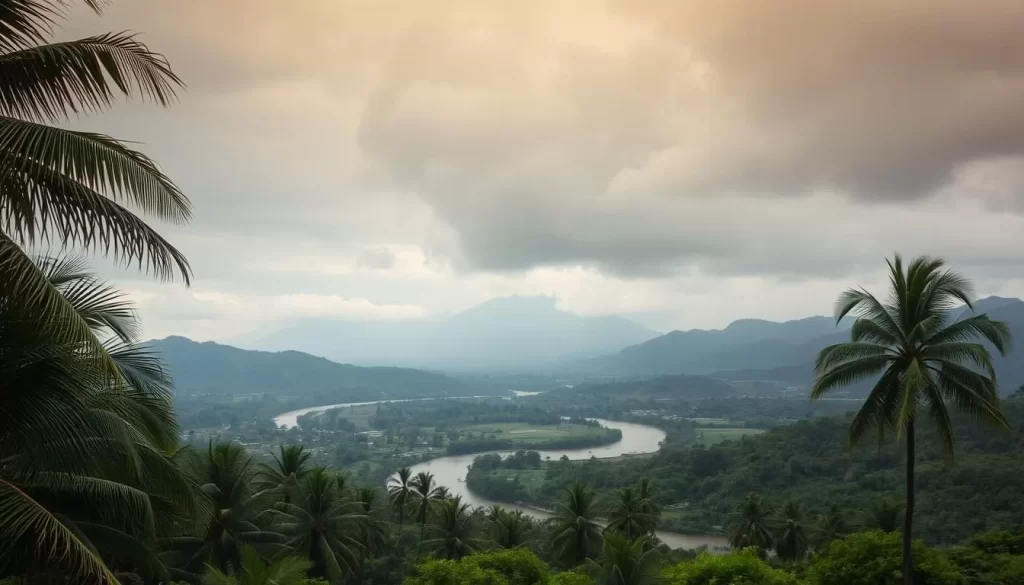
Northeast Monsoon (October-November)
As the Southwest Monsoon begins to subside, the Northeast Monsoon takes over in October, bringing another spell of rain. Although less frequent, the downpours during this period are often more intense, contributing significantly to the annual rainfall.
By late October, the rain patterns become more predictable, usually occurring in the late afternoons or evenings. This allows for a more planned approach to activities, with mornings often being rain-free.
| Month | Rainfall Characteristics | Tourist Season |
|---|---|---|
| October | Less frequent but intense rainfall | Early tourist season starts |
| November | Gradually decreasing rainfall and humidity | Pre-peak season, ideal for early visitors |
November marks the end of the monsoon season, with the climate transitioning into winter. The decreasing humidity and pleasant temperatures make it an ideal time to visit before the peak tourist season begins.
The end of the monsoon season coincides with harvest festivals and cultural celebrations across Kerala, offering visitors a unique glimpse into local traditions and customs.
Kerala, India: Best Months for a Weather-Savvy Trip
The best months to visit Kerala, India, can significantly enhance your travel experience with pleasant weather and fewer crowds. Understanding the optimal time to plan your trip is crucial for making the most of your journey.
Optimal Weather Windows
Kerala’s climate varies throughout the year, making some periods more suitable for travel than others. The peak tourist season from December to February offers optimal weather conditions, with comfortable temperatures and low humidity, making it ideal for sightseeing and outdoor activities. However, this period comes with higher prices and crowded attractions.
In contrast, the shoulder seasons of October-November and February-March provide a great balance between good weather and manageable tourist numbers, with prices being 15-30% lower than during the peak season.
- The peak season is perfect for those who prioritize optimal weather.
- Shoulder seasons offer a more relaxed experience with lower prices.
Balancing Weather with Crowd Levels
For travelers on a budget, considering the off-season, particularly June to September, can result in significant savings of up to 50% on accommodations. However, this requires flexibility regarding rainfall and humidity.
It’s also worth noting that different destinations within Kerala experience varying crowd patterns. For instance, hill stations become more crowded during summer, while coastal areas see fewer visitors during this time. Strategically timing your visits to popular attractions, such as early mornings or weekdays, can greatly enhance your experience.
- Budget travelers can benefit from off-season discounts.
- Flexibility with travel dates can lead to a more enjoyable trip.
Month-by-Month Guide to Kerala’s Weather and Festivals
Understanding the monthly weather patterns and festivals in Kerala is crucial for planning a memorable trip. Kerala’s climate and cultural calendar offer a diverse experience throughout the year, making it essential to align your visit with the activities and weather that suit your preferences.
Winter Months: December-February
Kerala’s winter months are characterized by pleasant weather, with temperatures ranging from 20°C to 25°C. This period is ideal for exploring the state’s natural beauty, including its backwaters, hill stations, and beaches. You can enjoy a variety of activities such as boat cruises, trekking, and wildlife spotting. The festival season during this time includes events like the Thrissur Pooram, a vibrant celebration known for its decorated elephants and fireworks.
December marks the beginning of the peak tourist season, with Christmas and New Year celebrations attracting visitors. January and February continue the dry and cool weather, making them excellent months for outdoor activities and cultural experiences. You should consider visiting during this time if you prefer a more relaxed atmosphere before the peak season crowds.
Summer Months: March-May
As summer sets in, Kerala experiences rising temperatures and humidity. While this might be challenging for some travelers, it’s also a good time to find travel deals and enjoy the state’s lush landscapes rejuvenated by pre-monsoon showers. The summer months host various festivals, including the Vishu festival, which marks the Malayalam New Year. It’s a time of cultural celebrations and traditional feasts.
During these months, you can still enjoy water activities and explore Kerala’s cultural heritage. The season also offers a chance to experience the local cuisine, with many restaurants serving traditional dishes. If you’re looking for a more laid-back and affordable trip, summer could be a good time to visit Kerala.
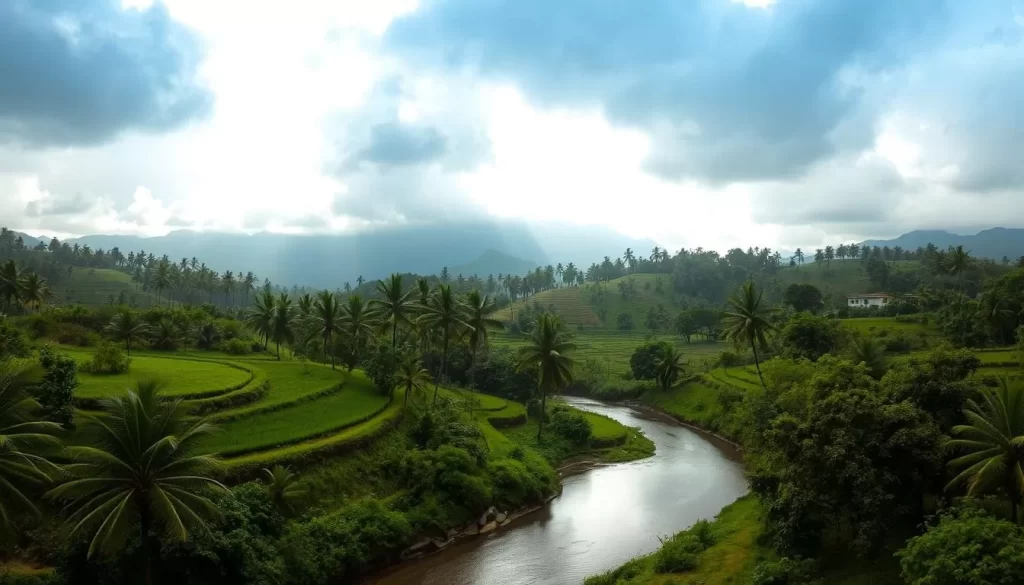
Monsoon Months: June-November
The onset of the monsoon in June transforms Kerala into a lush, green paradise. While the heavy rains might deter some, this period offers a unique charm and lower prices for accommodations and tourist services. The monsoon season is also a time for various cultural and religious events, such as the Champakkulam Boat Race and Kottiyoor Utsavam. These festivals showcase the rich cultural heritage of Kerala and provide a glimpse into its traditions.
As the monsoon progresses, July and August experience the heaviest rainfall, but they also host unique festivals like Aanayoottu, the ceremonial feeding of temple elephants. September celebrates Onam, a ten-day harvest festival that is one of Kerala’s most significant cultural events, featuring floral decorations, traditional feasts, and boat races. October and November transition into the Northeast monsoon, with significant religious celebrations and a gradual shift towards winter conditions.
Regional Weather Guide: Where to Go When
Kerala’s climate varies significantly across its different regions, including coastal areas, hill stations, and backwater regions, each with its own ideal visiting time. Understanding these regional weather variations is key to planning a trip that makes the most of Kerala’s diverse landscapes.
Coastal Kerala
The coastal regions of Kerala, including popular destinations like Kochi and Thiruvananthapuram, experience a tropical climate with high humidity throughout the year. The best time to visit these areas is from October to February when the weather is relatively cooler and more pleasant, making it ideal for beach activities and sightseeing. During this period, you can enjoy water sports and explore the local culture without the discomfort of excessive heat.
Hill Stations and Mountains
Kerala’s hill stations, such as Munnar and Wayanad, offer a cooler climate compared to the plains and coastal areas. The best time to visit these hill stations is during the summer months (March to May) when the temperature is pleasant, and the landscapes are lush. This period is perfect for trekking and enjoying the natural beauty of the hills. The monsoon season also transforms these areas into lush green paradises, but some places may be inaccessible due to heavy rainfall.
Backwater Regions
The backwaters of Kerala, including Alleppey and Kumarakom, are best visited from October to February. During this time, the weather is pleasant, and the calm waters make it ideal for houseboat cruises and village tours. The winter season offers comfortable daytime temperatures and cool evenings, creating perfect conditions for exploring the backwaters. You can also consider visiting during October and early November for a post-monsoon experience with lush landscapes and fewer tourists.
Experiencing Kerala’s Unique Festivals by Season
The festivals of Kerala are a window into the soul of this Indian state, showcasing its deep-rooted traditions and celebrations. Kerala’s festivals are not just events; they are experiences that immerse you in the local culture, history, and spirituality.
Major Cultural Celebrations
Kerala is renowned for its vibrant cultural celebrations, which peak between January and May. During this period, the state hosts numerous temple and elephant festivals, featuring elaborate processions, traditional music, and fireworks. One of the most spectacular events is the Thrissur Pooram, which takes place in late April or May, showcasing over 30 decorated elephants and traditional percussion ensembles.
- Theyyam performances in northern Kerala, representing one of the world’s oldest ritual art forms, with over 400 distinct deity embodiments.
- The Attukal Pongala, a festival that holds the Guinness World Record for the largest gathering of women for a religious activity.
Temple Festivals and Religious Events
Temple festivals in Kerala are a significant part of the state’s cultural identity, tracing their history back thousands of years. These festivals preserve ancient rituals, performance traditions, and artistic expressions, offering visitors unparalleled cultural insights. The snake boat races during July-September are another unique event, combining athletic competition with religious tradition.
| Festival | Time of Year | Description |
|---|---|---|
| Thrissur Pooram | April-May | Spectacular religious event with decorated elephants and traditional percussion |
| Theyyam Performances | December-April | Ancient ritual art form with deity embodiments |
| Attukal Pongala | February-March | Largest gathering of women for a religious activity |
| Snake Boat Races | July-September | Athletic competition combined with religious tradition |

Weather-Based Activities in Kerala
You can enjoy various activities in Kerala, depending on the season. The state’s diverse climate and geography offer a range of experiences for visitors.
Dry Season Adventures
During the dry season, from December to February, Kerala is ideal for outdoor activities. You can explore the backwaters and enjoy a relaxing boat ride. The pleasant weather is also perfect for trekking in the Western Ghats, where you can experience the rich biodiversity of the region. Visiting the hill stations like Munnar is another great option, with their tea plantations and scenic views.
Monsoon Experiences
The monsoon season transforms Kerala into a lush green paradise, making it an ideal time for certain activities. The monsoon enhances the beauty of Kerala’s landscapes, with waterfalls like Athirappilly and Vazhachal reaching their peak. This season is particularly beneficial for those interested in Ayurvedic treatments, as the humid climate makes the body more receptive to herbal oils and therapies. Additionally, the monsoon offers unique opportunities for photography, with misty landscapes and dramatic cloud formations.
Some of the activities you can enjoy during the monsoon include specialized trekking with guides, exploring indoor cultural experiences like Kathakali performances and cooking classes, and visiting museums to learn about Kerala’s rich heritage.
Practical Tips for Weather-Savvy Travelers
Being weather-savvy is key to enjoying your time in Kerala to the fullest. Understanding the local climate and being prepared can make a significant difference in your travel experience.
Packing Essentials by Season
Packing the right clothing and accessories according to the season is vital. During the monsoon season, it’s advisable to bring waterproof gear and quick-drying clothes. In the dry season, light, breathable clothing is recommended. For summer, prioritize light, loose-fitting clothes that protect you from the heat.
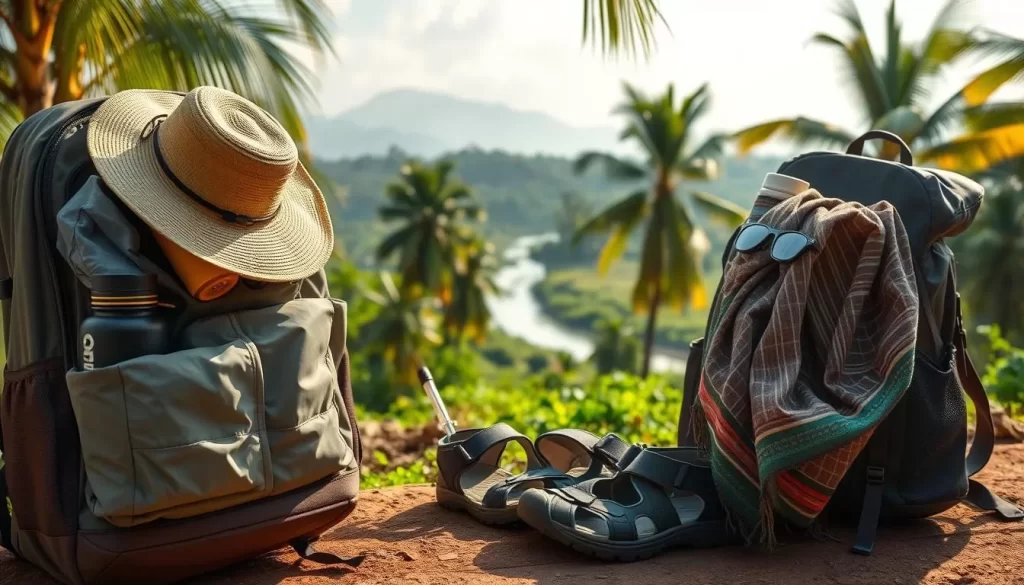
Health and Safety Considerations
When traveling to Kerala, especially during the monsoon or summer, health and safety should be a priority. To avoid waterborne diseases, drink only bottled or purified water and avoid street food during heavy rains. The high humidity during certain seasons can lead to fungal infections, so keeping your skin dry is crucial. Additionally, protecting yourself against mosquito-borne illnesses with repellents and appropriate clothing is essential. Staying hydrated, especially during the hot summer months, by drinking 3-4 liters of water daily is also vital.
By following these tips and being mindful of the season you’re traveling in, you can ensure a safe and enjoyable trip to Kerala. Whether you’re looking to travel during the peak season or explore during the off-peak months, being prepared is key.
Conclusion
Kerala, known as ‘God’s Own Country,’ is a year-round destination that offers something unique for every traveler. The state’s diverse climate means that each season presents unique advantages: winter brings perfect weather and cultural festivals, summer offers budget opportunities and hill station retreats, while monsoon transforms the landscape into a lush paradise ideal for Ayurvedic treatments.
By understanding Kerala’s tropical climate and the characteristics of its three distinct seasons, you can plan a trip that aligns with your preferences and budget. Whether you’re looking to relax on the beaches, explore the backwaters, or indulge in local cuisine, Kerala has something to offer. The best time to visit Kerala is from October to February when the weather is pleasant, making it ideal for comprehensive exploration.
Ultimately, the best time for your trip depends on your personal preferences, budget considerations, and desired activities. With this guide, you’re equipped to make an informed decision that aligns with your travel goals.
The above is subject to change.
Check back often to TRAVEL.COM for the latest travel tips and deals.
Here are some Tours & Sightseeing suggestions that might pique your interests!
